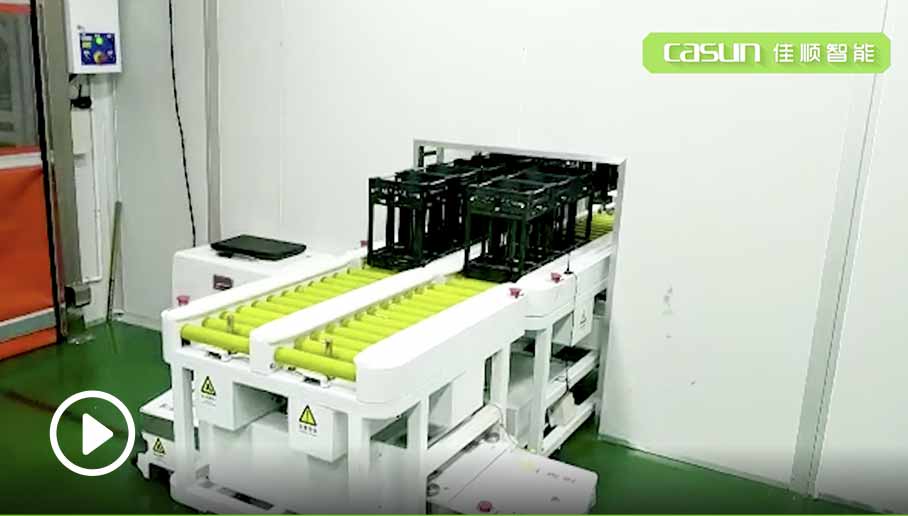 Focus on AGV industry for 18 years
Focus on AGV industry for 18 years
 Focus on AGV industry for 18 years
Focus on AGV industry for 18 years
The PACK production line of a leading company in the new energy lithium battery industry is facing increasingly complex production demands, requiring a highly reliable and precise smart logistics solution to enhance overall efficiency. This production line involves multiple processes, with diverse and frequent material handling needs between different workstations. The design of the smart logistics system must fully consider the specific requirements of each workstation to ensure timely delivery and accurate placement of materials. Additionally, real-time monitoring and adjustments during the production process are necessary to ensure coordinated operations across all stages, avoiding production bottlenecks caused by handling delays.
To achieve efficient and smooth operation of the production line, the AGV control system will be interface-connected with the workshop's MES system and the PLCs of key workstations. This integration will ensure that the AGV/AMR can instantly acquire status information from the production line, thereby optimizing dispatch strategies and rationally arranging handling tasks. Through seamless integration with the workshop systems, the AGV/AMR can not only enhance production efficiency but also improve resource utilization, reducing manual intervention and operational errors. The successful implementation of this project will provide the customer with robust technical support in the competitive market, further solidifying their leading position in the electric vehicle sector.

The PACK assembly line includes both manual and automated workstations, requiring AGV/AMR to precisely control stops, releases, and circulation operations between different stations. Each workstation has different operational requirements and processes, necessitating that AGV/AMR possesses high-precision positioning and motion control capabilities to ensure the smooth completion of handling tasks. Such precision demands pose greater challenges to the stability and reliability of AGV/AMR.
AGV/AMR must interact with the workshop PLC system via a wireless network for real-time data exchange, ensuring the safety and stability of the material handling process. The complexity of the production environment may lead to signal interference and network delays; therefore, AGV/AMR must have strong anti-interference capabilities and real-time data processing abilities to promptly respond to PLC commands under changing production conditions and achieve efficient collaboration.
AGV/AMR must be compatible with various sizes of material carts and adapt to the full range of products in the PHEV series. Differences in size, weight, and shape among different products require AGV/AMR to have flexible adaptability and the ability to automatically recognize and adjust handling strategies. This necessitates that the AGV system be equipped with modular design and intelligent control to effectively cope with changes and challenges on the production line.

CASUN Intelligent Robotics has designed and implemented a highly customized smart logistics comprehensive solution to address the complex needs of the PACK flexible production line for this project:
Automatic Circulation and Precise Scheduling:An automated circulation system composed of over 100 AGVs/AMRs achieves efficient flow between different workstations through a hybrid navigation method using magnetic strips. The CRMS system receives and processes commands from various workstations in real-time, ensuring precise coordination of material handling.
Bidirectional Signal Transmission and Operational Control:AGV/AMR realizes bidirectional signal transmission with the PLC system, ensuring smooth operations when entering and leaving workstations. At manual operation stations, "pull cord signals" and "release signals" are used to schedule vehicles, reducing manual intervention and improving operational efficiency. Additionally, AGV/AMR can provide real-time feedback on operational status, optimizing the production workflow.
Online Charging and Continuity of Production:Each workstation is equipped with charging points to ensure that AGV/AMR devices can operate online for extended periods, enhancing production continuity and stability. The charging system is designed to support stable operation of AGV/AMR even under high load conditions, further improving overall production efficiency.


100+ AGV/AMRs achieve automatic cycling and precise scheduling, ensuring efficient material flow and improving production line rhythm and overall efficiency.

AGV/AMRs interact bidirectionally with the PLC system, enabling accurate docking and release at workstations, reducing manual intervention and minimizing operational errors.

Compatible with various sizes of material carts, meeting the needs of the entire production line. Equipped with anti-static and emergency stop functions to ensure safe and stable operation.

The CRMS system provides real-time monitoring and scheduling, optimizes path planning, reduces delays, and supports online charging to ensure continuous production.
